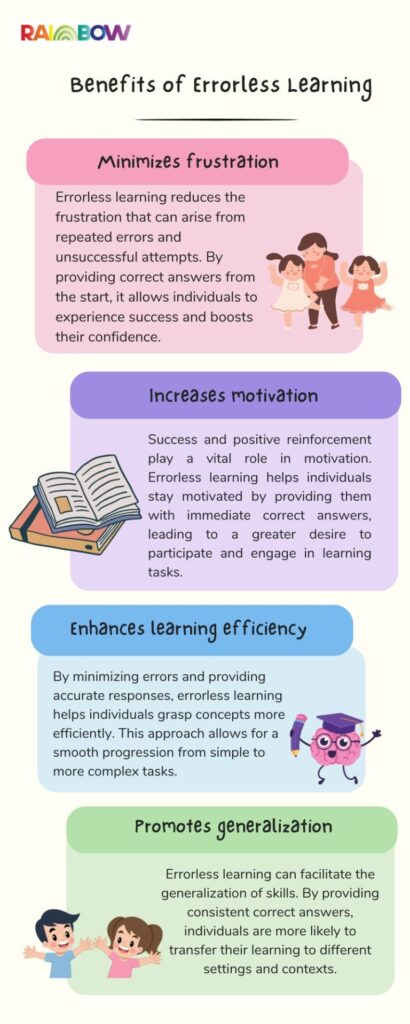In the field of Applied Behavior Analysis (ABA) therapy, errorless learning is an approach that focuses on minimizing errors and maximizing success during the learning process. This method aims to prevent individuals from giving incorrect responses by providing them with the correct answer immediately. By doing so, it reduces the likelihood of individuals experiencing frustration or confusion that may arise from trial and error learning.
The concept of errorless learning is based on the idea of carefully titrating the difficulty level of learning tasks. This ensures that individuals are able to learn and respond accurately without resorting to trial and error. By setting the stage for success, errorless learning creates a positive learning experience and promotes the acquisition of new skills.
What is Errorless Learning in ABA?
The goal of this method is to provide a high level of support initially and then gradually reduce this support as the learner gains competence. The technique is widely used particularly when working with individuals with developmental disorders such as autism.
The main premise behind errorless learning is that allowing learners to make errors might strengthen incorrect responses and lead to learning incorrect information or developing undesirable behaviors. Errorless learning aims to prevent this by ensuring that the learner experiences success repeatedly, which reinforces the correct behavior.
Benefits of Errorless Learning
Errorless learning offers several benefits, particularly for individuals with cognitive impairments, including those diagnosed with Autism Spectrum Disorder (ASD). By providing immediate correct answers, errorless learning helps individuals build accurate and successful responses. Some key benefits of errorless learning include:

Overall, errorless learning is a valuable approach in ABA therapy, particularly for individuals with cognitive impairments. By providing immediate correct answers and gradually reducing cues over time, errorless learning sets individuals up for success and promotes effective skill acquisition.
Implementing Errorless Learning
The procedures of errorless learning involve carefully structuring the learning environment to prevent errors and maximize success. Here are some key steps involved in implementing errorless learning:
- Prompting: Prompting is an essential component of errorless learning. It involves providing cues or assistance to guide the individual towards the correct response. Prompts can be physical, visual, verbal, or gestural, depending on the individual’s needs and abilities.
- Gradual Fading: As the individual becomes more proficient in a particular skill, prompts are gradually faded or reduced. This process ensures that the individual gradually takes on more independence and relies less on external cues.
- Reinforcement: Reinforcement is an important aspect of errorless learning. Providing positive reinforcement, such as praise, rewards, or tokens, helps motivate the individual and strengthen the learned behavior.
- Systematic Teaching: Errorless learning typically involves systematic teaching methods, which break down complex skills into smaller, more manageable steps. This approach allows for a gradual progression towards mastery.

Vanishing Cues Technique
The vanishing cues technique is a specific type of errorless learning that involves gradually reducing the amount of information provided to elicit the correct response. This technique helps individuals develop independent problem-solving skills and reduces dependence on external cues.
Here’s how the vanishing cues technique works:
- Full Prompting: Initially, a full prompt or cue is given to guide the individual towards the correct response. This ensures a high probability of success.
- Gradual Reduction: Over time, the amount of information provided as a cue is systematically reduced. This reduction can involve fading the physical or verbal prompts, removing visual cues, or reducing the level of assistance provided.
- Generalization: As the individual becomes more proficient, the cues are gradually faded across different settings and situations. This promotes generalization and helps the individual apply the learned skill in various contexts.
By employing the procedures of errorless learning and utilizing techniques like the vanishing cues method, ABA therapists can create a structured and supportive learning environment for individuals with autism. These approaches help build strong foundations and enhance skill acquisition while minimizing errors and frustration.
Error Correction Procedures
Error correction procedures are designed to address and correct any errors made by the individual during the learning process. By providing appropriate feedback and support, error correction procedures help individuals learn from their mistakes and reinforce the correct response.
Importance of Error Correction
Error correction plays a crucial role in the learning process, especially in ABA therapy. It allows for immediate feedback and helps individuals understand their errors, guiding them towards the correct response. By addressing errors promptly, error correction procedures prevent the reinforcement of incorrect responses and promote the acquisition of accurate skills and behaviors.
Error correction also helps to build resilience and persistence in individuals. By providing guidance and support, it encourages them to continue trying and learning from their mistakes. It is important to remember that errors are a natural part of the learning process, and error correction procedures help individuals develop the necessary skills for success.
Strategies for Error Correction
There are various strategies that can be employed for error correction in ABA therapy. The choice of strategy depends on the individual’s needs and the specific learning task. Here are some commonly used error correction strategies:
- Prompting: Prompting involves providing additional cues or hints to help the individual arrive at the correct response. Prompting can be done verbally, physically, or visually, depending on the individual’s learning style and needs. Gradually fading prompts over time encourages independent responding.
- Modeling: Modeling involves demonstrating the correct response for the individual. The therapist or caregiver performs the desired behavior, allowing the individual to observe and imitate the correct response. Modeling can be particularly effective for individuals who learn through observation.
- Reinforcement of Correct Response: When an error occurs, it is important to immediately reinforce the correct response. This helps to strengthen the association between the correct response and positive reinforcement, promoting the individual’s understanding of the correct behavior.
- Time Delay: Time delay is a technique that involves introducing a brief pause before providing the correct response. This allows the individual an opportunity to generate the correct response independently before receiving assistance. Time delay promotes independence and reduces prompt dependency.
- Errorless Teaching: Errorless teaching is a proactive approach that aims to prevent errors from occurring in the first place. This involves carefully structuring learning trials to provide the correct answer immediately and gradually reducing cues over time. The method of vanishing cues is a type of errorless learning that involves reducing the amount of information given to provide the correct answer over a period of time.
By employing these strategies and tailoring them to the individual’s needs and learning style, error correction procedures in ABA therapy can effectively address errors, reinforce correct responses, and facilitate skill acquisition.
Errorless Learning in ASD
Errorless learning has been particularly beneficial for individuals with Autism Spectrum Disorder (ASD). The structured nature of errorless learning provides predictability and reduces anxiety, which is essential for individuals with ASD who often thrive in structured environments. By minimizing errors and providing immediate correct responses, errorless learning helps individuals with ASD build confidence and develop skills in a positive and supportive manner.
Research has shown that errorless learning can be effective in teaching various skills to individuals with ASD, including language and communication, daily living skills, and academic tasks. The individualized approach of errorless learning allows for tailoring interventions to meet the specific needs and abilities of each individual with ASD.
Practitioners integrating these concepts in behavioral interventions must plan strategically to balance the need for teaching new, desirable behaviors (via errorless learning) and phasing out undesired behaviors (potentially involving extinction).
By utilizing errorless learning techniques, ABA therapists can create a learning environment that is conducive to the unique learning styles of individuals with ASD. The structured prompts and gradual reduction of cues in errorless learning provide a framework for success, promoting skill acquisition and positive learning experiences.
Conclusion
Errorless learning in ABA Therapy Services represents a powerful educational technique, designed to ensure success and boost confidence among learners by minimizing the chance of mistakes and gradually increasing task complexity. This approach not only helps reinforce positive behavior and skills in individuals with developmental disorders, such as autism, but also promotes a stress-free learning environment where the fear of failure is significantly reduced.
Through the strategic use of prompts and their careful fading, errorless learning makes acquiring new skills accessible and enjoyable, fostering an atmosphere where learners can thrive without the discouragement typically associated with trial-and-error methods. Ultimately, errorless learning in ABA therapy underscores a compassionate, learner-focused approach to education that can yield profound and lasting benefits.

